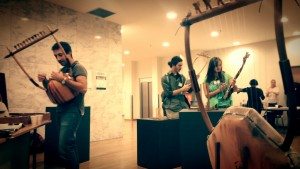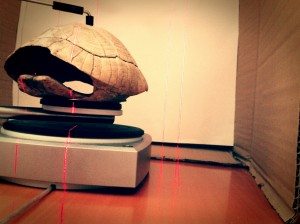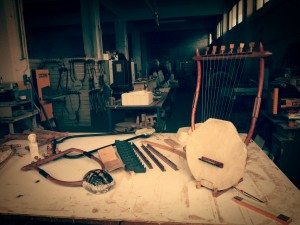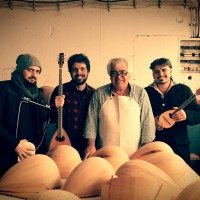
Nikolaos and Anastasios Koumartzis of Luthieros music instruments. Photo © Luthieros music instruments.
For the ancient Greeks, music was viewed, quite literally, as a gift from the gods. It was an integral part of life weaving its way into education, athletic and military activities, and events such as weddings and funerals. The term music in ancient Greece also covers dance, lyrics, and the performance of poetry. The ancient Greeks used many instruments to create their music like the panpipes and aulos (flute). However, the most well known would be the lyre a stringed musical instrument. Luthieros Music Instruments is a Greek company and family run business that creates playable lyres based on the structure of those played by the ancient Greeks.
In this interview, Jade Koekoe of Ancient History Encyclopedia (AHE) speaks with Mr. Theodore Koumartzis, global communication supervisor and team member of Luthieros Music Instruments.
JK: Γεια σας Mr. Theodore Koumartzis, welcome to Ancient History Encyclopedia (AHE). I understand you are part of the team at Luthieros Music Instruments. Can you tell us a little bit about Luthieros? How did it start?
TK: The Koumartzis family is full of musicians. We were raised to respect the musical heritage of Greece (both ancient and modern), and before long we felt the need to promote all this rich heritage around the world. So we have decided to focus on producing top-quality musical instruments (starting with ancient Greek lyres, more than 2.500 years old) and reintroduce them to the modern global music community.

The Lyre of Sappho II – Ancient Greek Barbiton Lyre (7 strings). Photo © Luthieros music instruments.
We set up our workshop near our homeland, ancient Europos (Northern Greece), where our ancestors used to live and evolve in a full cultural environment. It is not an exaggeration to say that the first people ever called Europeans were the ancient citizens of Europos (based on archaeological evidence found in the area). This unique heritage is present in our whole product line.
The heart of Luthieros Musical Instruments is our father Anastasios. He is an amateur musician (of more than 40 years), a best-selling author of do-it-yourself music instrument guides in Greek and a Luthier. Anastasios, using his rich experience in constructing Greco-Turkish stringed instruments (Bouzouki, Baglamas, Tzouras), helped bring to fruition “The Lyre 2.0 Project”.
This project was initiated by Nikolaos Koumartzis, my brother, as part of his MSc Product Design thesis at the International Hellenic University (IHU). He managed to cooperate with the 3d Labs of IHU for the reverse-engineering and 3d scanning stage, and with the Sound Labs of Journalism Department (Aristotle University of Thessaloniki). As you can see, this project has strong academic roots. Nikolaos gave a lecture at the 2014 Hellenic Conference of Acoustics, and during December 2015 his paper will be published (in English) in the Journal of New Music Research (co-authored by scientists working in three different Greek universities).
Based on the aforementioned research, along with a lot of hand crafting and sophisticated manufacturing techniques, we are able to produce beautiful instruments with a rich unique sound, at a fair price for music lovers around the world. We strongly believe that music is among the most straightforward intermediates for communication, so we focus on providing the right “tools” to make that happen (i.e. music instruments that can be seen as unique artifacts).
JK: You produce many different variations of lyres, all of which have fantastic names, which allude to aspects of ancient Greek myth and culture. Could you describe some of the differences between the various lyres you produce and some of the myths that inspired their nomenclature?
TK: First of all, it is really interesting to know and be able to identify the differences between several types of ancient lyres. According to the ancient Greek mythology, the first lyre was made by god Hermes, using a tortoise shell as a sound box, cow skin as a resonator and animal horns as arms. This lyre was named chelys by the word χέλυς, meaning turtle in ancient Greek.
Later on, the barbiton lyre with its different “round shaped” arms came along. The Phorminx and the Kithara of the Golden Age are instruments mainly made of wood (it has been historically proven that wood was used later on during ancient times for its musicality and great sound).
There are also different types of ancient lyre-like instruments such as sambuca (probably invented by the poet Ibycus in the 6th century BCE, and first played by a wandering woman called Sibyl) and Epigonion (an ancient Greek harp, invented by a legendary musician and instrument inventor: Epigonus of Ambracia.).
But simply learning the name of an instrument is not enough. You need to know about its essence, its history, and its value during antiquity… What it meant to be able to play a Kithara. What it meant to be able to afford to pay a kitharodo (player of ancient Kithara). And of course, there is even more: the myths, all of them, full of hidden (musical or not) meanings!
“In the deep still woods upon the Thracian mountains Orpheus with his singing lyre led the trees, Led the wild beasts of the wilderness.” – Orpheus and Eurydice.
JK: In the Homeric Hymn to Hermes, we are told how the messenger-god created the first chelys lyre from a tortoise he found, using its shell as a sound box for the instrument. Could you elaborate on how you source the various natural materials that you use to make your instruments?

People playing instruments made by Luthieros music instruments. Photo © Luthieros music instruments.
TK: Homer, Philostratus the Elder, Virgil, Ovid etc., along with numerous depictions on amphorae and limited but valuable archaeological finds, helped us lay the foundations for “The Lyre 2.0 Project”.
We used top-notch 3d technologies (3d scanning and 3d modeling) for the rapid prototyping phase. At the end of the prototyping phase, we focused on producing the first fully functional models of ancient Greek lyres: one of the chelys type, and one of the barbiton type. Both of them were constructed using only materials available during the antiquity such as tortoise shell for the resonator, bone for the plectrum, leather for the soundboard, metal for the tailpiece, animal’s guts for the strings, wood for the arms, the bridge etc.
Based on the feedback we got at the end of each stage, we managed to produce many more lyre versions, before we settled on the ones that are now available to the global music community.
As we are animal welfare supporters, we could not use actual tortoise shells for our product line. So, we had to figure out an alternative way to have the same authentic sound and aesthetic qualities. After a long research (using 3d scanning technologies once more), we concluded by producing artificial replicas of tortoise shells with the same exact dimensions, shape, outer form etc.
JK: Your website mentions “The Lyre 2.0 Project”, how was that idea born, what research have you undertaken to develop it and what is its goal?
TK: Everything started based on an idea of my brother, Nikolaos Koumartzis (the middle son of our family). He was doing his MSc in Product Design at International Hellenic University, when he realized that an instrument with such a great history, like the ancient lyres, was not available for the public, i.e. for anyone that might want to learn how to play it or use it in her/ his music. There were only some replicas in museums or private collections, some of which were not even able to produce music.
So, the main reason and ultimate goal for “The Lyre 2.0 Project” was to produce top quality and authentically looking ancient lyres, using only natural materials available during the antiquity (with the only exception being the artificially replicated tortoise shell), at a fair price!
Our ancient lyre’s product line is available at our website or on our Etsy store.
And we have managed to do it! Thanks to the help of academics and scientists of three Greek universities (International Hellenic University, Dept. of Journalism of Aristotle University of Thessaloniki and Technological Education Institution of Western Macedonia), the long and very specialized experience of luthier Anastasios and the talent of great musicians around the world, “The Lyre 2.0 Project” became well-known to the music community and was invited to participate in conferences, journals, live performances and international fairs.
JK: Many of your instruments are supplied with a guidebook so that the notes of ancient Greek scales can be played properly. Could you describe how these ancient scales differ to those played in modern Western music?
TK: At this part, I feel that Michael Levy (the most well-known ancient lyre player around the world and one of the main Luthieros.com musicians) is the one that should answer. So, I quote him:
“For composition using modern major and minor keys, there is basically a bland choice to compose a melody that sounds either “happy” or “sad” – using the ancient Greek modes, in addition to these basic emotional palettes, it is possible to create new melodies which can best be described as intense with the ability can increase concentration in the listener, music which can sound either “manly” or “feminine” in character, melodies which sound dream-like, music that can sound erotic, melodies with a playful character, music which is triumphant and music can invoke sorrow…
Adding the wonderfully pure-sounding just intonation of antiquity into this incredible tapestry of available acoustic landscapes in which to compose in, intensifies the unique feel and character of each of these wonderful ancient Greek modes even further, to create an almost 3-dimensional vista of ‘sculpture in sound’!”
You can also learn to play the ancient lyre, in 11 lessons with Michael Levy.
JK: Before concluding our interview, can you share with us any future collaborations Luthieros has planned?
TK: Almost every month brings us a new collaboration, something that we could not imagine would happen. So, we learned not to plan for the distant future.
For example, during the last six months we managed to bring Michael Levy to Greece for his first live performances here, we showed Futaba Sato playing our ancient Lyre of Erato at Tokyo University, Lina Palera performed during the greatest ancient Greek festival in Mount Olympos and Peter Pringle endorsed our Kithara of the Golden Age in Canada (and its unique vibrato mechanism).
What’s more, our 3-day Festival under the title “The Gift of Gods” took place in Thessaloniki (2nd largest city in Greece) with an amazing participation by music-lovers, an exhibition area, numerous lectures and workshops! Finally, we even took part in the last MusikMesse in Frankfurt (the biggest music instrument exhibition in Europe), and recently a Hollywood music producer contacted us for a collaboration for a movie soundtrack. Finger-crossed, we hope to announce more information officially soon!
And lastly a Game of Thrones music collaboration played with Luthieros.com ancient lyres:
[embedyt] http://www.youtube.com/watch?v=MD6uXXZwfi8[/embedyt]
Luthieros Music Instruments is a Greek family-based company. The Koumartzis familia have been making replicas of ancient Greek instruments such as the Lyre for many years. They also contribute to their musical passions through research and collaborations. Their creations have been used by famous lyre players like Mr. Michael Levy and used to recreate modern music like the Game of Thrones theme song.
All images featured in this interview have been attributed to their respective owners. Images lent to the Ancient History Encyclopedia by Luthieros Music Instruments have been done so as a courtesy for the purposes of this interview. Unauthorized reproduction is strictly prohibited. All rights reserved. © AHE 2015. Please contact us for rights to republication.




